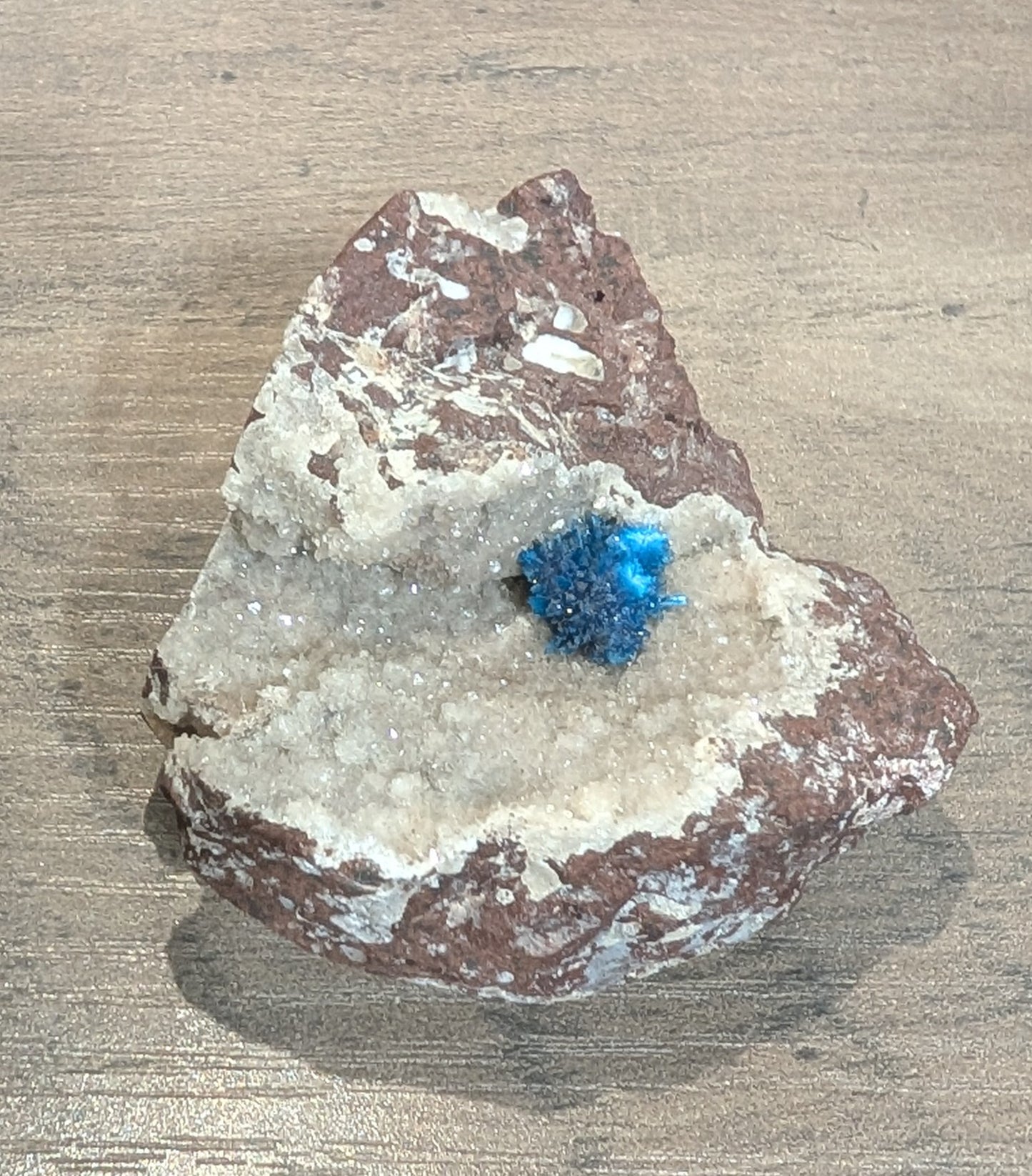Auglocqnuk
Cavansite on Heulandite
Cavansite on Heulandite
Couldn't load pickup availability
Cavansite on heulandite is a natural mineral specimen characterized by vibrant blue cavansite crystals growing on a matrix of heulandite, often forming striking, rosette-like clusters that resemble "pom-poms". This association is common, with cavansite frequently found alongside other minerals such as stilbite, apophyllite, and calcite. The specimen is highly valued by collectors for its unique appearance and rarity.
The formation of cavansite on heulandite occurs within volcanic environments, specifically in cavities or vesicles within basaltic rocks. The process begins with volcanic activity, where molten lava cools and traps gases, creating void spaces. Subsequently, hydrothermal activity brings hot, mineral-rich water into these cavities. The introduction of calcium, vanadium, and silicon from these fluids triggers the crystallization of cavansite, which belongs to the zeolite group of minerals. As the hydrothermal fluids cool, cavansite crystals grow, often forming aggregates of small, prismatic or tabular crystals. The heulandite matrix typically forms under similar conditions, providing the structural foundation for the cavansite growth.
What makes cavansite on heulandite unique is its intense, vibrant blue color, which is attributed to the presence of vanadium in its chemical composition. This color is distinctive and not found in any other natural mineral species. The mineral is relatively rare, with significant deposits primarily located in the Deccan Traps region of India, particularly around Pune, Maharashtra, and also found in the USA, Brazil, and New Zealand. Cavansite has a Mohs hardness of approximately 3, making it relatively soft and fragile, which limits its use in jewelry but enhances its appeal as a collector's specimen. Its physical properties include a vitreous luster, transparency to translucency, and a white streak. Some specimens also exhibit fluorescence under ultraviolet light.
How do cavansite and pentagonite differ?
Cavansite and pentagonite are dimorphs, meaning they share the same chemical composition, Ca(V⁴⁺O)Si₄O₁₀·4H₂O, and are both calcium vanadium phyllosilicates with a vibrant blue color due to the presence of vanadium in the +4 oxidation state. They crystallize in the orthorhombic system and are found in similar geological environments, primarily within the Deccan Traps of India and a few other locations like Oregon, USA. Despite their similarities, they differ significantly in their crystal structure, physical appearance, and formation conditions.
The most notable difference lies in their crystal habit and morphology. Cavansite typically forms spherulitic rosettes, which are compact, ball-like clusters of short, blunt, needle-like crystals. In contrast, pentagonite also forms from spherulitic rosettes but grows into distinct, individual, elongated prismatic crystals with pointed terminations that can extend up to several centimeters in length. These elongated crystals are often described as acicular and can exhibit a characteristic five-branched, pentagon-like cyclic twinning, which is a key identifier for pentagonite. This twinning is not observed in cavansite.
Their physical properties also differ. Pentagonite generally exhibits a deeper, more intense ultramarine blue color compared to the brighter, teal-blue hue of cavansite. The structural differences between the two minerals are profound. Cavansite has a more compact structure with 8-membered rings of SiO₄ tetrahedra joined by 4-membered rings, and its calcium atoms are coordinated by eight oxygen atoms, four from silicate sheets and four from water molecules. Pentagonite has 6-membered rings of SiO₄ tetrahedra, and its calcium atoms are coordinated by only seven oxygen atoms, with one water molecule hydrogen-bonded to other water molecules and silicate oxygen atoms. This structural difference results in cavansite having a lower ground-state energy and a slightly smaller volume (about 2.7% less) than pentagonite.
These structural and energetic differences explain their relative rarity. Cavansite is more common and is considered a low-temperature form, while pentagonite is rarer and is thought to form under higher-temperature conditions. Theoretical studies suggest that the lower energy state of cavansite makes it the more stable phase under typical conditions, and the probability of pentagonite formation is very low at temperatures below 650K. The water molecules in cavansite are also less tightly bound than those in pentagonite, making them easier to remove, which may influence their stability and formation.
Due to their visual similarity, misidentification is common in the mineral market, and the term "pentagonite" is sometimes used abusively to justify higher prices for specimens that are actually cavansite. Without specialized analysis, such as X-ray diffraction, it is impossible to definitively distinguish between the two based on appearance alone.
Share


